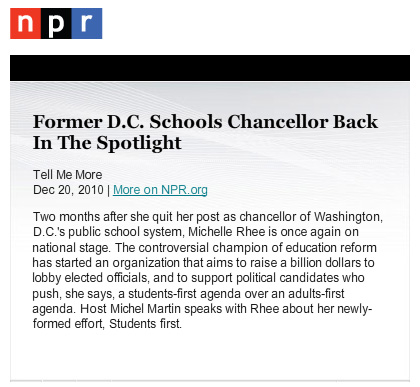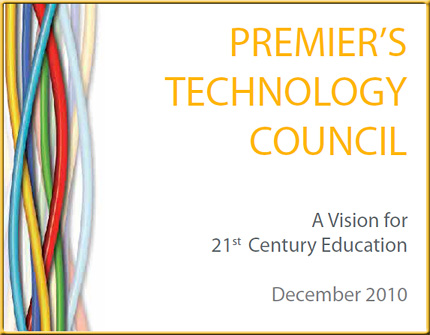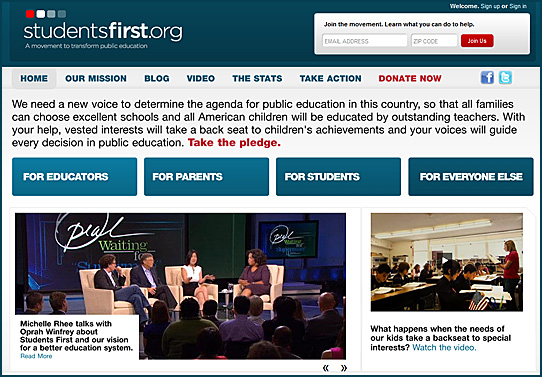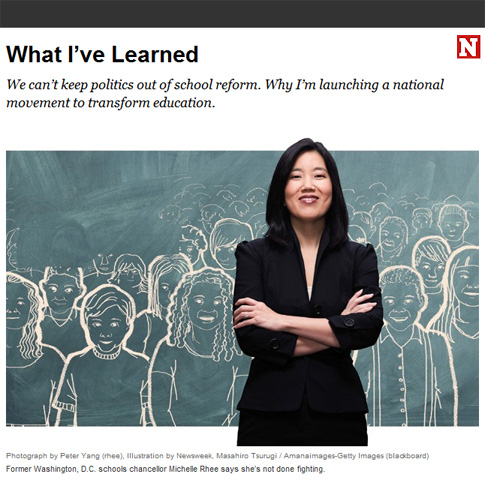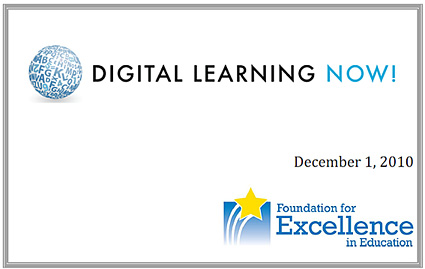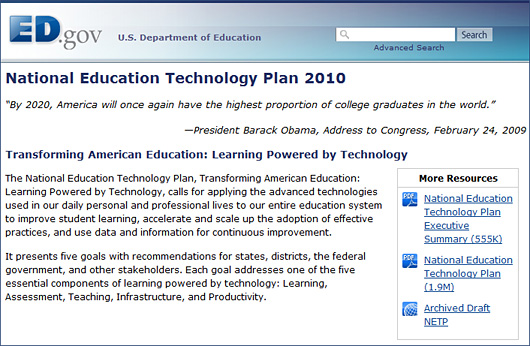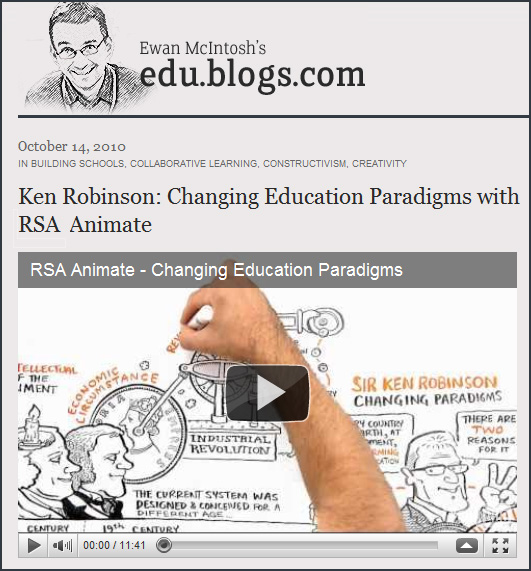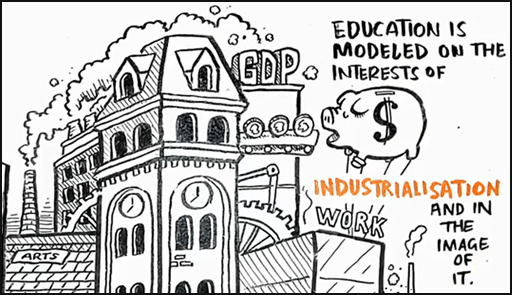Table of Contents
Executive Summary
Introduction
Building a Knowledge-Based Society
The Needs of a Knowledge-Based Society
Case Study: Finland
Vision of Education for the 21st Century
Case Study: Singapore
How Would the System Function?
Case Study: China
Shifting Roles
Conclusion
Appendix A – Measuring 21st Century Skills
Numeracy and Mathematics
Reading Literacy
Creativity
ICT/Technological Literacy
Digital Literacy
Appendix B – Consultations & Acknowledgments
Appendix C – PTC Members & Staff
Bibliography
Some quotes:
From Learning Information to Learning to Learn:
The system must place greater emphasis on the learning of skills over the learning of content.
From Data to Discovery:
Content will have to evolve constantly, not only to remain relevant but so students are ready to deal with how rapidly information changes in a knowledge-based society.
From One Size Fits All to Tailored Learning:
As students progress they will increasingly access and engage with their own content, at their own pace of learning and take an increasing role in charting a path best suited to those talents, interests and abilities.
From Testing to Assess to Assessing to Learn:
Technology allows educators and students to assess progress more regularly than with traditional classroom assessments and to identify and address each student’s challenges as they arise. This is in contrast to tests and exams that measure what a student learned at the end of an instructional unit by which time it is often too late to address shortcomings.
From Classroom Learning to Lifelong Learning:
Lifelong learning can be encouraged by incorporating aspects of a student’s life outside of school into their education.
How would the system function?
- A Blended System:
The system would have a mixture of face-to-face classroom and online learning. It would also incorporate the immense range of learning opportunities outside the classroom. Some students would prefer a heavier emphasis on classroom learning while others may prefer the options of online learning. There has already been a strong uptake of online learning in BC. - Access to Learning Objects and Teaching Tools:
Technology allows for better access to learning objects, teaching tools, and information. This is important for students, parents and teachers to collaborate in creating an individualised learning path that incorporates the information they need to know in more customised ways. - Open Access to Information Systems:
Students need to be able to access information. Unfettered (but not unguided) access will allow them to learn and to teach themselves as they go forward. Furthermore, access to information will allow students to make informed decisions about their interests and understand the implications of new information for potential career decisions. - Constant Feedback and Assessment:
While the system will be more flexible, there is a need for assessment based standards that will be higher in the future than they are today. Technology can provide new options for assessment and improving learning outcomes. In particular it allows for timely assessment so that students, parents and teachers can be informed during, not after, learning and in ways that allow for correction and celebration.
Education-related quotes from:
Poverty: ending the cycle
A 36-year study by Concordia University looks at the cycle of poverty through three generations of Montrealers
The third generation, growing up right now in this technological society, has no bright future without high school, Serbin says.
“Lack of education causes huge barriers, and these kids have a lot farther to go than others,” she says, “because they come from backgrounds with little education and stimulation.”
So is it any wonder that the dropout rate isn’t budging? Serbin asks.
“(Premier Jean) Charest talks about parents providing support, which is great. But how do you enable parents to do that?”
We need to teach parents the skills and offer them programs and support, so they in turn can support their children academically, she says. If poverty places parents in acute stress, how is it possible for them to help their children without outside support?
From DSC:
To me, this begins to get at the heart of the matter of education reform — helping develop stable, solid families with parents that actively support the education of their children.
It’s tough — if one was never taught the importance of education, how does one acquire that perspective? We need to help parents build a respect for education. But I realize that when a person is out there just trying to get by at all, it’s hard to worry about education. That’s why next year, I hope to begin offering a program on developing digital literacy to those children who come out of a background of significant need. I want to help them identify, develop and use their passions.
In the raging controversy over the purpose of public education and how to fix the nation’s underperforming schools, the voices of America’s best teachers are seldom heard. Now for the first time, in a provocative book about the future of teaching and learning, 12 of America’s most accomplished classroom educators join a leading advocate for a 21st-century teaching profession to bring expert pedagogical know-how and fresh and provocative policy ideas to the national school reform debate. Together they identify four emergent realities that will shape the learning experience of children born in the New Millennium — and propose six levers of change that can ignite a bright future for our nation’s students by ensuring they all have access to excellent teaching. To create the public schools all students deserve, today and tomorrow, the authors call on policymakers and the public to work with teachers in creating a dynamic and flexible learning environment for students and teachers, and powerful new ways to define and measure school success; transforming public education through digital technologies while reinventing brick and mortar school buildings into 24/7 hubs of community support for students and families; re-imagining teaching as a well-compensated career with many pathways, assuring that every child has qualified and effective teachers and that teaching expertise is constantly spread, in and out cyberspace; establishing a new leadership force of 600,000 teacherpreneurs — classroom experts who continue to teach students regularly while also serving as teacher educators, policy researchers, community organizers, and trustees of their profession.
Teaching 2030 provides a refreshing, grounded, and lively examination of what we need to know and do in order to ensure that every public school student in America has access to qualified, caring, and effective teachers.
About the Author
Barnett Berry is founder and president of the Center for Teaching Quality, based in North Carolina–a nonprofit that seeks to dramatically improve student achievement nationwide by conducting timely research, crafting smart policy, and cultivating teacher leadership. The TeacherSolutions 2030 Team includes Jennifer Barnett (Alabama); Kilian Betlach (California); Shannon C’de Baca (Iowa); Susie Highley (Indiana); John M. Holland (Virginia); Carrie J. Kamm (Illinois); Renee Moore (Mississippi); Cindi Rigsbee (North Carolina); Ariel Sacks (New York); Emily Vickery (Florida); Jose Vilson (New York); Laurie Wasserman (Massachusetts).
The Coming Age of the Teacherpreneur — from edweek.org by Barnett Berry & the TeacherSolutions 2030 Team
In an excerpt from a forthcoming book on the future of education, a group of accomplished educators envisions new roles for teacher leaders.
Excerpt:
Ultimately, teacherpreneurship is about propagating a new culture of innovation and creativity in a sector of education that has been woefully lacking in one. Most importantly, teacherpreneurship is not promoting a free-market vision for the profit of a few—but rather how our society can invest substantially in teachers who can expertly serve millions of children and families who are not in the position to choose a better school somewhere else or find the most erudite online teacher anytime, anywhere. Teacherpreneurship is all about the public good, not private gain.










